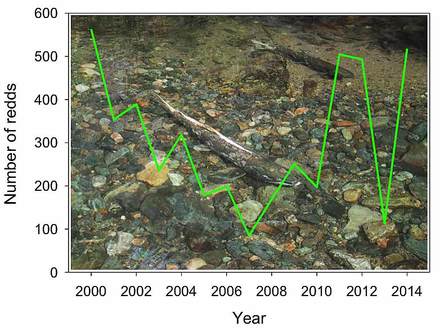 Chinook salmon on a redd and annual counts of redds for the Middle Fork Chinook salmon population Chinook salmon on a redd and annual counts of redds for the Middle Fork Chinook salmon population One of the most popular methods to measure salmon numbers in a watershed is to monitor spawning adults and their redds (nests). Mature Chinook salmon return each year to the Middle Fork John Day River during May and June. They spend the summer months seeking cool water while holding in deep pools. When the weather starts to cool in September they begin spawning by digging redds and laying their eggs in the gravel. These redds are easily observed and are a common method to measure the abundance of spawning salmon. Each year Oregon Department of Fish & Wildlife (ODFW) fish biologists walk the Middle Fork John Day River to count redds to estimate the number of spawning adults (for details, see Bare et al. 2014). Redd counts for the 2014 spawning season were impressive. ODFW biologists estimated that > 500 redds were constructed within the Middle Fork IMW area during 2014. This is a 350% increase from 2013 counts and the highest on record since 2000. Redd counts throughout the John Day River basin were similarly high. The detection of this high abundance of redds demonstrate the potential for salmon in the Middle Fork John Day River. However, our previous data has shown that high abundance of redds does not directly translate into more juvenile offspring, suggesting that the freshwater environment in the Middle Fork is limiting the potential for increasing the salmon population. Summer water temperatures in the Middle Fork have also killed many adult salmon in 2007 and 2013 resulting in very low redd counts for those years. The inability of the freshwater environment to produce more offspring despite high numbers of spawning adults and their deposited eggs is a central reason for continued restoration actions within the Middle Fork IMW.
1 Comment
|
IMW News Updates
Archives
September 2022
Categories |
 RSS Feed
RSS Feed
